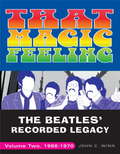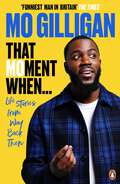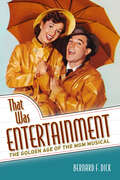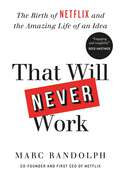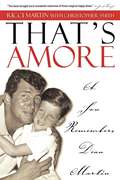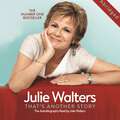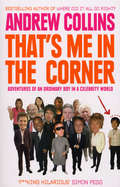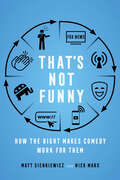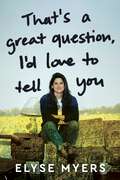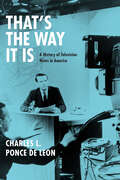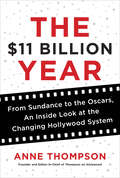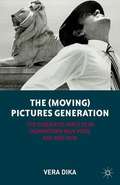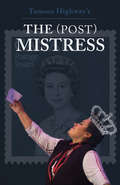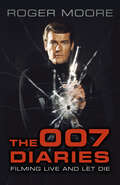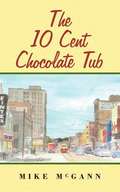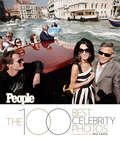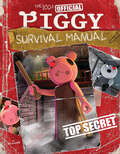- Table View
- List View
That Magic Feeling Volume Two, 1966-1970: The Beatles' Recorded Legacy
by John C. WinnA chronicle of the Beatles' remarkable story, "That Magic Feeling" examines their recorded legacy on tape and film. With more than 500 entries covering hundreds of hours of recordings, this is a must-have for Beatles fans.
That Moment When: Life Stories from Way Back Then
by Mo GilliganCome on my journey. Look at where man's come from. I was working in retail in 2017.You might know Mo as the critically acclaimed stand-up comedian, BAFTA-winning presenter, Masked Singer judge and social media mega star. But do you know the moments that really made him? Opening up on the turning points, the good times, the challenges and the lessons learned, this is Mo as you've never seen him before.Journeying through childhood memories in South London, Mo reminisces about school days and old-school raving, and takes us behind the scenes of his first comedy gigs, the creation of the original Geezer, selling out national tours and becoming one of TV's most in-demand stars. Share the moment that Mo decided he wanted to be a comedian, the moment he went viral, the moment he realised he was famous (and how to deal with it), the moment his Netflix special dropped, the moment he won his BAFTA and the moments he still has to come.In among the laugh-out-loud observations, life lessons and candid storytelling, there lies the bigger influences in Mo's life - the unsung heroes of the Black British comedy scene, the power of community and the feel-good legacy he wants to create.'The Funniest Man in Britain' The Times
That Thing about Bollywood
by Supriya KelkarBollywood takes over in this contemporary, magical middle grade novel about an Indian American girl whose world turns upside down when she involuntarily starts bursting into glamorous song-and-dance routines during everyday life. <P><P>You know how in Bollywood when people are in love, they sing and dance from the mountaintops? Eleven-year-old Sonali wonders if they do the same when they’re breaking up. The truth is, Sonali’s parents don’t get along, and it looks like they might be separating. Sonali’s little brother, Ronak, is not taking the news well, constantly crying. Sonali would never do that. <P><P>It’s embarrassing to let out so many feelings, to show the world how not okay you are. But then something strange happens, something magical, maybe. When Sonali gets upset during a field trip, she can’t bury her feelings like usual—instead, she suddenly bursts into a Bollywood song-and-dance routine about why she’s upset! The next morning, much to her dismay, Sonali’s reality has shifted. <P><P>Things seem brighter, almost too bright. Her parents have had Bollywood makeovers. Her friends are also breaking out into song and dance. And somehow, everyone is acting as if this is totally normal. Sonali knows something has gone wrong, and she suspects it has something to do with her own mismanaged emotions. Can she figure it out before it’s too late?
That Time of Year: A Minnesota Life
by Garrison KeillorWith the warmth and humor we've come to know, the creator and host of A Prairie Home Companion shares his own remarkable story. In That Time of Year, Garrison Keillor looks back on his life and recounts how a Brethren boy with writerly ambitions grew up in a small town on the Mississippi in the 1950s and, seeing three good friends die young, turned to comedy and radio. Through a series of unreasonable lucky breaks, he founded A Prairie Home Companion and put himself in line for a good life, including mistakes, regrets, and a few medical adventures. PHC lasted forty-two years, 1,557 shows, and enjoyed the freedom to do as it pleased for three or four million listeners every Saturday at 5 p.m. Central. He got to sing with Emmylou Harris and Renée Fleming and once sang two songs to the U.S. Supreme Court. He played a private eye and a cowboy, gave the news from his hometown, Lake Wobegon, and met Somali cabdrivers who&’d learned English from listening to the show. He wrote bestselling novels, won a Grammy and a National Humanities Medal, and made a movie with Robert Altman with an alarming amount of improvisation. He says, &“I was unemployable and managed to invent work for myself that I loved all my life, and on top of that I married well. That&’s the secret, work and love. And I chose the right ancestors, impoverished Scots and Yorkshire farmers, good workers. I&’m heading for eighty, and I still get up to write before dawn every day.&”
That Voice: In Search of Ann Drummond-Grant, the Singer Who Shaped My Life
by Marcia MenterAs an adolescent in Syracuse, New York, Marcia Menter fell in love with the recorded voice of Ann Drummond-Grant, a Scottish contralto who sang with the D’Oyly Carte Opera Company, the legendary Gilbert and Sullivan troupe. She dreamed of singing with the company, even though it didn’t hire Americans—and even though, as she soon found out, Ann Drummond-Grant had died years earlier. But her dream persisted, and for the young music lover, Drummie’s glorious voice remained a living presence—a refuge from the race riots and political upheavals of her school years. Menter earned a conservatory degree in singing before finally realizing she was not a performer at heart. She spent decades searching for Ann Drummond-Grant—visiting places she lived and interviewing people who knew her—and putting together the puzzle of her life. This is the story of a singer and her listener—of two separate lives divided by time and geography but connected in unexpected ways.
That Was Entertainment: The Golden Age of the MGM Musical
by Bernard F. DickThat Was Entertainment: The Golden Age of the MGM Musical traces the development of the MGM musical from The Broadway Melody (1929) through its heyday in the 1940s and 1950s and its decline in the 1960s, culminating in the notorious 1970 MGM auction when Judy Garland's ruby slippers from The Wizard of Oz, Charlton Heston's chariot from Ben-Hur, and Fred Astaire's trousers and dress shirt from Royal Wedding vanished to the highest bidders.That Was Entertainment uniquely reconstructs the life of Arthur Freed, whose unit at MGM became the gold standard against which the musicals of other studios were measured. Without Freed, Judy Garland, Gene Kelly, Fred Astaire, Ann Miller, Betty Garrett, Cyd Charisse, Arlene Dahl, Vera-Ellen, Lucille Bremer, Gloria DeHaven, Howard Keel, and June Allyson would never have had the signature films that established them as movie legends.MGM's past is its present. No other studio produced such a range of musicals that are still shown today on television and all of which are covered in this volume, from integrated musicals in which song and dance were seamlessly embedded in the plot (Meet Me in St. Louis and Seven Brides for Seven Brothers) to revues (The Hollywood Revue of 1929 and Ziegfeld Follies); original musicals (Singin' in the Rain, Easter Parade, and It's Always Fair Weather); adaptations of Broadway shows (Girl Crazy, On the Town, Show Boat, Kiss Me Kate, Brigadoon, Kismet, and Bells Are Ringing); musical versions of novels and plays (Gigi, The Pirate, and Summer Holiday); operettas (the films of Jeanette MacDonald and Nelson Eddy); mythico-historical biographies of composers (Johann Strauss Jr. in The Great Waltz and Sigmund Romberg in Deep in My Heart); and musicals featuring songwriting teams (Rodgers and Hart in Words and Music and Kalmar and Ruby in Three Little Words), opera stars (Enrico Caruso in The Great Caruso and Marjorie Lawrence in Interrupted Melody), and pop singers (Ruth Etting in Love Me or Leave Me). Also covered is the water ballet musical--in a class by itself--with Esther Williams starring as MGM's resident mermaid. This is a book for longtime lovers of the movie musical and those discovering the genre for the first time.
That Will Never Work: The Birth of Netflix by the first CEO and co-founder Marc Randolph
by Marc RandolphIn the tradition of Phil Knight's Shoe Dog comes the incredible untold story of how Netflix went from concept to company - all revealed by co-founder and first CEO Marc Randolph.Once upon a time, brick-and-mortar video stores were king. Late fees were ubiquitous, video-streaming unheard of, and widespread DVD adoption seemed about as imminent as flying cars. These were the widely accepted laws of the land in 1997 when Marc Randolph had an idea. It was a simple thought - leveraging the internet to rent movies - and was just one of many more proposals, like personalised baseball bats and a shampoo delivery service, that Randolph would pitch to his business partner, Reed Hastings, on their commute to work each morning. But Hastings was intrigued, and the pair - with Hastings as the primary investor and Randolph as the CEO - founded a company. Now with over 150 million subscribers, Netflix's triumph feels inevitable but the twenty-first century's most disruptive start-up began with few believers and calamity at every turn. From having to pitch his own mother on being an early investor, to the motel conference room that served as a first office, to server crashes on launch day, to the now-infamous meeting when they pitched Blockbuster to acquire them, Marc Randolph's transformational journey exemplifies how anyone with grit, gut instincts and determination can change the world - even with an idea that many think will never work. What emerges, however, isn't just the inside story of one of the world's most iconic companies. Full of counter-intuitive concepts and written in binge-worthy prose, it answers some of our most fundamental questions about taking that leap of faith in business or in life: How do you begin? How do you weather disappointment and failure? How do you deal with success? What even is success? From idea generation to team building to knowing when it's time to let go, That Will Never Work is not only the ultimate follow-your-dreams parable but also one of the most dramatic and insightful entrepreneurial stories of our time. (p) 2019 Octopus Publishing Group
That Will Never Work: The Birth of Netflix by the first CEO and co-founder Marc Randolph
by Marc RandolphIn the tradition of Phil Knight's Shoe Dog comes the incredible untold story of how Netflix went from concept to company - all revealed by co-founder and first CEO Marc Randolph."Engaging and insightful." --Reed Hastings, CEO of Netflix "As the founding CEO, Marc Randolph's leadership defined the culture of Netflix and laid the groundwork for successive, global revolutions in how we make and consume entertainment." --Gina Keating, author of Netflixed: The Epic Battle for America's Eyeballs "Charming, fascinating and very funny. If you've ever wondered how to turn an idea into a global household name, Marc Randolph will demystify the world of Silicon Valley start-ups, and make you laugh a lot along the way." --Decca Aitkenhead, The Sunday Times "A charming first-person account of the early days of one of the most successful tech start-ups ever. An engaging read that will engross any would-be entrepreneur." --The Washington PostOnce upon a time, brick-and-mortar video stores were king. Late fees were ubiquitous, video-streaming unheard of, and widespread DVD adoption seemed about as imminent as flying cars. These were the widely accepted laws of the land in 1997 when Marc Randolph had an idea. It was a simple thought - leveraging the internet to rent movies - and was just one of many more proposals, like personalised baseball bats and a shampoo delivery service, that Randolph would pitch to his business partner, Reed Hastings, on their commute to work each morning. But Hastings was intrigued, and the pair - with Hastings as the primary investor and Randolph as the CEO - founded a company. Now with over 150 million subscribers, Netflix's triumph feels inevitable but the twenty-first century's most disruptive start-up began with few believers and calamity at every turn. From having to pitch his own mother on being an early investor, to the motel conference room that served as a first office, to server crashes on launch day, to the now-infamous meeting when they pitched Blockbuster to acquire them, Marc Randolph's transformational journey exemplifies how anyone with grit, gut instincts and determination can change the world - even with an idea that many think will never work. What emerges, however, isn't just the inside story of one of the world's most iconic companies. Full of counter-intuitive concepts and written in binge-worthy prose, it answers our most fundamental questions about taking that leap of faith in business or in life: How do you begin? How do you weather disappointment and failure? How do you deal with success? What even is success? From idea generation to team building to knowing when it's time to let go, That Will Never Work is not only the ultimate follow-your-dreams parable but also one of the most dramatic and insightful entrepreneurial stories of our time. "Marc wastes no time cutting through the noise. He understands what is important whether it is your product, your marketing, or your business plan. A remarkable and one of a kind visionary." --Mitch Lowe, founder of RedBox and CEO of MoviePass "An entertaining chronicle of creativity, luck, and unflagging perseverance." --Kirkus
That's Amore: A Son Remembers Dean Martin
by Christopher Smith Ricci MartinRicci Martin takes readers on a tour through his childhood, from the star-studded parties to the exploration of three marriages, eight kids, one family, to the treasured one-on-one time he shared with his father.
That's Another Story: The Autobiography
by Julie WaltersHer mum wanted her to be a nurse so that is what Julie did.But in her heart she had always wanted to be an actress and soon she was on stage at the local theatre in Liverpool. Her career snowballed with highlights that include Educating Rita, Billy Elliot, Harry Potter, Acorn Antiques, Dinner Ladies and Mamma Mia! She has been nominated for an Oscar, been awarded a BAFTA and a Golden Globe, plus been honoured with both an OBE and a CBE. This is the heart-warming and funny story of that journey.
That's Another Story: The Autobiography
by Julie WaltersThe number-one Sunday Times bestseller'Walters's book - also well written - has moments of Alan Bennett warmth' SUNDAY TIMES'This is a humorous and, at times, moving read from this much-loved actress' WOMAN AND HOME'I was enthralled by her memoirs ... a celebrity memoir which is actually worth reading as a work of literature' AN Wilson, READER'S DIGESTHer mum wanted her to be a nurse so that is what Julie did.But in her heart she had always wanted to be an actress and soon she was on stage at the local theatre in Liverpool. Her career snowballed with highlights that include Educating Rita, Billy Elliot, Harry Potter, Acorn Antiques, Dinner Ladies and Mamma Mia! She has been nominated for two Oscars, been awarded multiple BAFTAs and a Golden Globe, plus been honoured with a DBE. This is the heart-warming and funny story of that journey.
That's Another Story: The Autobiography
by Julie WaltersThe number-one Sunday Times bestseller'Walters's book - also well written - has moments of Alan Bennett warmth' SUNDAY TIMES'This is a humorous and, at times, moving read from this much-loved actress' WOMAN AND HOME'I was enthralled by her memoirs ... a celebrity memoir which is actually worth reading as a work of literature' AN Wilson, READER'S DIGESTHer mum wanted her to be a nurse so that is what Julie did.But in her heart she had always wanted to be an actress and soon she was on stage at the local theatre in Liverpool. Her career snowballed with highlights that include Educating Rita, Billy Elliot, Harry Potter, Acorn Antiques, Dinner Ladies and Mamma Mia! She has been nominated for an Oscar, been awarded a BAFTA and a Golden Globe, plus been honoured with both an OBE and a CBE. This is the heart-warming and funny story of that journey.Read by Julie Walters(p) 2008 Orion Publishing Group
That's Me in the Corner: Adventures of an ordinary boy in a celebrity world
by Andrew CollinsFast approaching his fortieth birthday, Andrew is cornered at a family gathering by the nine-year-old son of his brother-in-law's sister. Having seen him as a talking head on TV, the boy asks, 'What are you?' It is a question so frank and simple that Andrew doesn't have an immediate answer to hand.So, with hilarious self-deprecation, he sets out to retrace how he got to where he is today. Seventeen precarious jobs in seventeen years: from trolley collector at Sainsbury's to high-flying film critic sipping cocktails with Will Smith and Jerry Bruckheimer on a yacht in Cannes. This is Andrew's tale of rubbing shoulders with the world's biggest stars: pissing off Christini Ricci, having his hairstyle mocked by Noel Gallagher, trying not to wake Clive James from his afternoon nap, having his apple pie eaten by Bob Geldof, and somehow stumbling into the next dream job.Along the way, he's been the world's worst gossip columnist, an almost-hip young gunslinger at the NME, a Radio 1 DJ (enduring a hellish Radio 1 roadshow in a car park in Birmingham), an ITV presenter, EastEnders scriptwriter, ghost writer for a major TV personality and much, much more. It charts a world of hedonism, mundanity, towering egos, shallow idiocy and occasional moments of mind-blowing joy. And, of course, being sent shit in a box.
That's Not Funny: How the Right Makes Comedy Work for Them
by Matt SienkiewiczA rousing call for liberals and progressives to pay attention to the emergence of right-wing comedy and the political power of humor. "Why do conservatives hate comedy? Why is there no right-wing Jon Stewart?" These sorts of questions launch a million tweets, a thousand op-eds, and more than a few scholarly analyses. That's Not Funny argues that it is both an intellectual and politically strategic mistake to assume that comedy has a liberal bias. Matt Sienkiewicz and Nick Marx take readers––particularly self-described liberals––on a tour of contemporary conservative comedy and the "right-wing comedy complex." In That's Not Funny, "complex" takes on an important double meaning. On the one hand, liberals have developed a social-psychological complex—it feels difficult, even dangerous, to acknowledge that their political opposition can produce comedy. At the same time, the right has been slowly building up a comedy-industrial complex, utilizing the humorous, irony-laden media strategies of liberals such as Jon Stewart, Samantha Bee, and John Oliver to garner audiences and supporters. Right-wing comedy has been hiding in plain sight, finding its way into mainstream conservative media through figures ranging from Fox News's Greg Gutfeld to libertarian podcasters like Joe Rogan. That's Not Funny taps interviews with conservative comedians and observations of them in action to guide readers through media history, text, and technique. You will find many of these comedians utterly appalling, some surprisingly funny, and others just plain weird. They are all, however, culturally and politically relevant—the American right is attempting to seize spaces of comedy and irony previously held firmly by the left. You might not like this brand of humor, but you can't ignore it.
That's Not Your Mommy Anymore: A Zombie Tale
by Matt MogkA twisted children&’s book parody that teaches kids what to do if mommy suddenly joins the legion of the undead. In the ongoing effort to warn an unprepared world of the rising danger from zombie attacks, one vulnerable group has been left out—small children. That's Not Your Mommy Anymore offers social workers, counselors, and educators a helpful new tool to communicate with hard-to-reach at-risk youth. This inviting and entertaining story helps early readers understand for themselves that a mom who has fresh brain casserole in the oven instead of her usual meatloaf is probably not their mommy anymore . . . This utterly twisted and incredibly funny take on the classic children&’s book genre tells an entertaining story in rhyming text even as it teaches other telltale signs that mom has been bitten by a zombie! Rabid zombie fans will be highly entertained by this hilarious parody that adult readers are sure to love as much as the real children books they enjoyed as kids.Praise for That&’s Not Your Mommy Anymore &“Younger kids might be a little frightened by the idea of a formerly loving mother who now wants to dine on human flesh, but older kids and grown ups will get a kick out of this tale.&” —GeekDad, Wired.com
That's a Great Question, I'd Love to Tell You
by Elyse MyersWriter, comedian, and content creator Elyse Myers gets real about life’s awkward moments in her bold, funny, and unfiltered debut bookElyse Myers is known to her twelve million followers as “The Internet’s Best Friend,” sharing her relatable stories and comedic sketches and serving as an advocate for topics such as neurodivergence, impostor syndrome, body image, and more. Whether she’s making people laugh with tales of disastrous dates or giving a voice to that awkward internal monologue many of us have, she has three simple goals behind everything she makes: To make people feel known, loved, and like they belong.In That's a Great Question, I'd Love to Tell You, Elyse delivers a debut collection of deeply personal stories and hand-drawn illustrations, offering even more intimate reflections beyond what fans have seen on her social media, including:Spending 7 Minutes in Heaven accidentally friend-zoning her crushHow Lucy, the Magic 8 Ball keychain, changed her life by accidentMoving from California to Australia to Texas to Nebraska to like (maybe even love!) herselfHow to Fold Hospital Corners in 10 EASY STEPS!—a practical guide and a rumination about…everythingThe “meat cute” when she met her smoke show of a husband at a butcher’s counter in Australia—and how she revealed herself to be an emotional runnerPlus, tales involving bad dates and is-this-a-dates; the tempting yet futile urge to reinvent yourself, panic attacks and escape hatches, and favorite pens and systems to use them, all while loving and letting yourself be loved, preferably at the same time.
That's the Way It Is: A History of Television News in America
by Charles L. Ponce de LeonWhen critics decry the current state of our public discourse, one reliably easy target is television news. It s too dumbed-down, they say; it s no longer news but entertainment, celebrity-obsessed and vapid. The critics may be right. But, as Charles L. Ponce de Leon explains in "That s the Way It Is," TV news has "always" walked a fine line between hard news and fluff. The familiar story of decline fails to acknowledge real changes in the media and Americans news-consuming habits, while also harking back to a golden age that, on closer examination, is revealed to be not so golden after all. Ponce de Leon traces the entire history of televised news, from the household names of the late 1940s and early 50s, like Eric Sevareid, Edward R. Murrow, and Walter Cronkite, through the rise of cable, the political power of Fox News, and the satirical punch of Colbert and Stewart. He shows us an industry forever in transition, where newsmagazines and celebrity profiles vie with political news and serious investigations. The need for ratings success and the lighter, human interest stories that can help bring it Ponce de Leon makes clear, has always sat uneasily alongside a real desire to report hard news. Highlighting the contradictions and paradoxes at the heart of TV news, and telling a story rich in familiar figures and fascinating anecdotes, "That s the Way It Is" will be the definitive account of how television has showed us our history as it happens. "
The "Femme" Fatale in Brazilian Cinema: Challenging Hollywood Norms
by Antônio Márcio da SilvaIn film, the femme fatale has long been constructed as a beautiful heterosexual Caucasian woman. Da Silva shows the need to incorporate diverse ethnic groups and male homosexuals into the range of "femmes" fatales and examines how the Brazilian representations cross gender, race, and class and offer alternatives to the dominant Hollywood model.
The $11 Billion Year: From Sundance to the Oscars, an Inside Look at the Changing Hollywood System
by Anne Thompson"This chronicle of 2012 is a slice of what happened during a watershed year for the Hollywood movie industry. It's not the whole story, but it's a mosaic of what went on, and why, and of where things are heading."What changed in one Hollywood year to produce a record-breaking box office after two years of decline? How can the Sundance Festival influence a film's fate, as it did for Beasts of the Southern Wild and Searching for Sugar Man, which both went all the way to the Oscars? Why did John Carter misfire and The Hunger Games succeed? How did maneuvers at festivals such as South by Southwest (SXSW), Cannes, Telluride, Toronto, and New York and at conventions such as CinemaCon and Comic-Con benefit Amour, Django Unchained, Moonrise Kingdom, Silver Linings Playbook, Les Misérables, The Life of Pi, The Avengers, Lincoln, and Argo? What jeopardized Zero Dark Thirty's launch? What role does gender bias still play in the industry? What are the ten things that changed the 2012 Oscar race?When it comes to film, Anne Thompson, a seasoned reporter and critic, addresses these questions and more on her respected daily blog, Thompson on Hollywood. Each year, she observes the Hollywood machine at work: the indies at Sundance, the exhibitors' jockeying at CinemaCon, the international scene at Cannes, the summer tentpoles, the fall's "smart" films and festivals, the family-friendly and big films of the holiday season, and the glamour of the Oscars®. Inspired by William Goldman's classic book The Season, which examined the overall Broadway scene through a production-by-production analysis of one theatrical season, Thompson had long wanted to apply a similar lens to the movie business. When she chose 2012 as "the year" to track, she knew that box-office and DVD sales were declining, production costs were soaring, and the digital revolution was making big waves, but she had no idea that events would converge to bring radical structural movement, record-setting box-office revenues, and what she calls "sublime moviemaking."Though impossible to mention all 670-plus films released in 2012, Thompson includes many in this book, while focusing on the nine Best Picture nominees and the personalities and powers behind them. Reflecting on the year, Thompson concludes, "The best movies get made because filmmakers, financiers, champions, and a great many gifted creative people stubbornly ignore the obstacles. The question going forward is how adaptive these people are, and how flexible is the industry itself?"
The (Moving) Pictures Generation
by Vera DikaBeginning in the late 1970s, a number of visual artists in downtown New York City returned to an exploration of the cinematic across mediums. Vera Dika considers their work within a greater cultural context and probes for a deeper understanding of the practice.
The (Post) Mistress
by Tomson HighwayMarie-Louise Painchaud has worked for thirty-five years as post mistress at the post office in Lovely, a francophone Canadian village where she has come to know every client whose mail she handles. The (Post) Mistress is a rollicking, emotional rollercoaster-ride in the form of a one-woman musical, with elements of jazz, Berlin cabaret, French café music, and Brazilian samba.
The 007 Diaries: Filming Live and Let Die
by Roger Moore David HedisonOut of print for over forty years, The 007 Diaries introduces Roger Moore’s James Bond Diary to a new generation of fans. To tie in with the release of his first James Bond film, Live and Let Die, Roger Moore agreed to keep a day-by-day diary throughout the film’s production, which would be published just ahead of the premiere in July 1973. From his unveiling as the new 007 in 1972 through to his first scenes on location in New Orleans and his final shot in New York, Moore describes his whirlwind journey as cinema’s most famous secret agent. Taking in the sights of Jamaica before returning to Pinewood Studios, Moore’s razor wit and unique brand of humour is ever present. With tales from every location, including his encounters with his co-stars and key crew members, Moore offers the reader an unusually candid, amusing and hugely insightful behind-the-scenes look into the world’s most successful film franchise.
The 10 Cent Chocolate Tub
by Mike Mcgann10 Cent Chocolate Tub will take you back to the 1950's and 1960s when life was uncomplicated. There were three channels to watch on a black and white television set showing Sid Caesar, Bishop Fulton J. Sheen, Howdy Doody, Milton Berle, fifteen minutes of Nat King Cole, The Lone Ranger and The Toast of The Town. Radio stations were AM only and played Elvis Presley, Doo-Wop music, Frank Sinatra, Doris Day, Patti Page, Chubby Checker and The Four Seasons, long before The Beatles came to America. The small things in life were exciting to a city boy who grew up to be a broadcaster, a Vietnam veteran, a minor performer and a dad! Everyone has family stories, crazy relatives, funny incidents, memories of how good things were back then and dreams of how they should be. The 10 Cent Chocolate Tub gets it's name from a huge chocolate ice cream cone sold by Bard's Dairy in the 1950s in Pittsburgh at a time when a young boy, who wore rummage sale clothes and ate surplus cheese, was only allowed a nickel vanilla ice cream now and then. This is about the quest for life's finer things like ice cream anytime you want it, playing the radio loudly, crying at a sad movie, falling in love, heartbreaks, kissing your children goodnight and loving every minute of it.
The 100 Best Celebrity Photos: And The Surprising Stories Behind Them
by The Editors of PEOPLESince its first issue debuted with a Great Gatsby portrait of Mia Farrow, People magazine has delivered not only outstanding celebrity journalism, but also the best in personality photography. Now, the Editors of People present The 100 Best Celebrity Photos.From a Marilyn Monroe pin-up to an internet-breaking Kim Kardashian Instagram, from Harry Benson's exuberant snaps of The Beatles' first visit to America to Bradley Cooper's star-packed Oscar selfie, these are the images that influenced how we understand fame and glamor.Included with each picture is the story behind it: A-list photographers tell how they created the images that turned stars into icons, or made legends seem as relatable as family. Here also are People exclusives from the magazine's history of unparalleled access into celebrity homes and off-duty lives that show us the real side of the stars who most captivate and intrigue us.
The 100% Official Piggy Survival Manual: An AFK Book
by ScholasticFans will not want to miss the very first official guide to PIGGY! Full of tips, tricks, lore, and more, this guide has everything you need to survive!Make it out alive with the official Piggy Survival Manual! This handbook includes everything you need to survive in the terror-filled world of PIGGY! Uncover secrets, master every book and chapter, and learn all there is to know about the world and characters of PIGGY.
